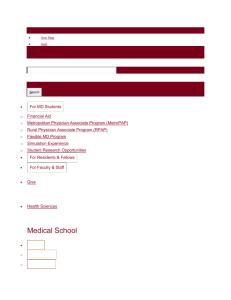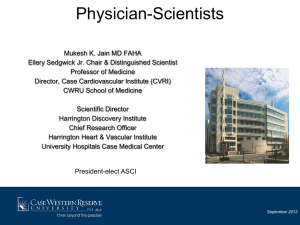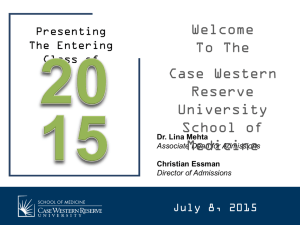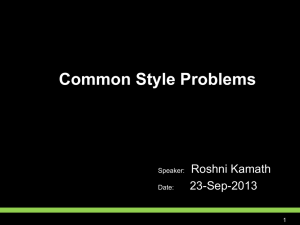OSUWMC Newsletter Template
advertisement
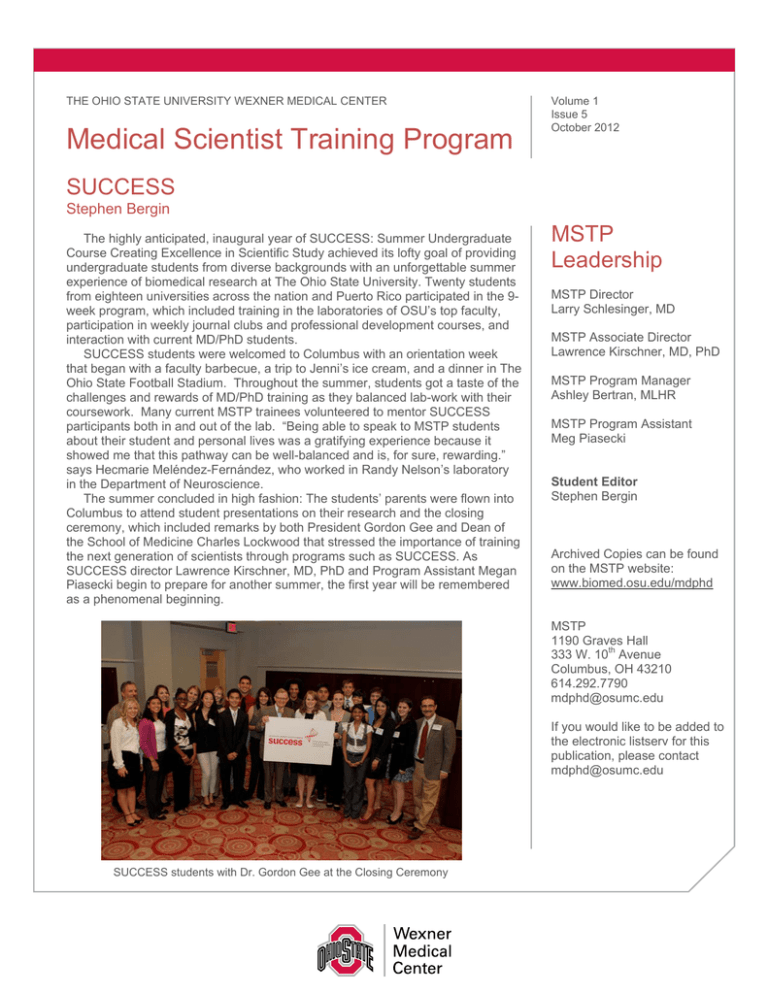
THE OHIO STATE UNIVERSITY WEXNER MEDICAL CENTER Medical Scientist Training Program Volume 1 Issue 5 October 2012 SUCCESS Stephen Bergin The highly anticipated, inaugural year of SUCCESS: Summer Undergraduate Course Creating Excellence in Scientific Study achieved its lofty goal of providing undergraduate students from diverse backgrounds with an unforgettable summer experience of biomedical research at The Ohio State University. Twenty students from eighteen universities across the nation and Puerto Rico participated in the 9week program, which included training in the laboratories of OSU’s top faculty, participation in weekly journal clubs and professional development courses, and interaction with current MD/PhD students. SUCCESS students were welcomed to Columbus with an orientation week that began with a faculty barbecue, a trip to Jenni’s ice cream, and a dinner in The Ohio State Football Stadium. Throughout the summer, students got a taste of the challenges and rewards of MD/PhD training as they balanced lab-work with their coursework. Many current MSTP trainees volunteered to mentor SUCCESS participants both in and out of the lab. “Being able to speak to MSTP students about their student and personal lives was a gratifying experience because it showed me that this pathway can be well-balanced and is, for sure, rewarding.” says Hecmarie Meléndez-Fernández, who worked in Randy Nelson’s laboratory in the Department of Neuroscience. The summer concluded in high fashion: The students’ parents were flown into Columbus to attend student presentations on their research and the closing ceremony, which included remarks by both President Gordon Gee and Dean of the School of Medicine Charles Lockwood that stressed the importance of training the next generation of scientists through programs such as SUCCESS. As SUCCESS director Lawrence Kirschner, MD, PhD and Program Assistant Megan Piasecki begin to prepare for another summer, the first year will be remembered as a phenomenal beginning. MSTP Leadership MSTP Director Larry Schlesinger, MD MSTP Associate Director Lawrence Kirschner, MD, PhD MSTP Program Manager Ashley Bertran, MLHR MSTP Program Assistant Meg Piasecki Student Editor Stephen Bergin Archived Copies can be found on the MSTP website: www.biomed.osu.edu/mdphd MSTP 1190 Graves Hall 333 W. 10th Avenue Columbus, OH 43210 614.292.7790 mdphd@osumc.edu If you would like to be added to the electronic listserv for this publication, please contact mdphd@osumc.edu SUCCESS students with Dr. Gordon Gee at the Closing Ceremony Lead Serve Inspire Inquire Investigate Zachary Hing and Sam Ohmer This past August, the newest MSTP students became the first class to fully integrate with their medical school peers in the new curriculum, Lead Serve Inspire Inquire Investigate (LSI3). This is an innovative change from the experience of past MSTP classes, in which the students were required to complete an independent study pathway, or ISP. Richard Price, a recent PhD recipient, comments, “The new curriculum has the benefit of structure while still leaving flexibility for an MSTP student to pursue research interests.” First year MSTP and traditional medical students alike, are getting used to the new curriculum, which is designed to offer more integrated learning of normal and pathological processes as well as enhanced preparation for Step 1, and many of them are actively taking advantage of the benefits, which include the thematic inclusion of diseases with basic biology, flexible e-Modules, and early exposure to clinical practice and skills. The flexibility of the curriculum allows students to complete curriculum components on their own time, at their own pace. Since the beginning of the school year, students have learned to take a full patient history and have practiced clinical procedures such as venipuncture, vital signs and injections. Beginning in October, students will take their newly acquired clinical skills into Ohio State’s hospitals and begin to care for real patients. Importantly, the new curriculum allows new MSTP students to experience their first year as a traditional medical student while maintaining a connection to research and basic science. Trainees arrived early in the summer to complete a laboratory rotation. For example, Jason Siu, a first year MSTP student interested in neuroscience, rotated with Dr. Karl Obrietan this summer and relates, “After interacting with all the members of the lab, with whom I enjoyed working, along with the PI, I believe I have found a great possible mentor for my thesis years.” Additionally, the LSI3 curriculum offers a new feature entitled Roundtable, which meets once a month to provide MSTP students the opportunity to discuss science over lunch with some of the university’s brightest faculty members, such as Drs. Maura Gillison and Patrick Nana-Sinkam. At Roundtable, first and second year MSTP trainees met with Dr. Nana-Sinkam and learned about his journey through medicine. Student Awards The Medical Scientist Training Program wishes to congratulate Nima Milani-Nejad on his recently-awarded American Heart Association Predoctoral Fellowship! The Medical Scientist Training Program wishes to congratulate Henry Chang n his recently-awarded American Heart Association Predoctoral Fellowship! The two year AHA fellowship was awarded for Henry's project "Cardiac MRI and Histologic Characterization of At-Risk Myocardium in a Canine Model of NSTE-ACS." Welcome, New Trainees! Kyle Beckwith: I grew up Temperance, Michigan and received my B.S. in Biochemistry from the University of Michigan in 2009. Later that year, I began medical school at OSU. I worked in Dr. Popovich’s laboratory during my first year, an experience that prompted me to pursue further research opportunities. Following completion of my second year of medical school, I received a Pelotonia fellowship to support a one year period of cancer research. As a Pelotonia fellow I have been working with Dr. Byrd and Dr. Muthusamy focusing on targeted therapies for chronic lymphocytic leukemia. This culminated in my decision to pursue a PhD and apply to the MSTP program. I believe this is the best path toward achieving my future goals, namely running a lab of my own. I look forward to joining this program and plan to focus on immunology and cancer biology. Outside of science and medicine, my interests include film, music, and cycling. David Clever: Hi, my name is David Clever and I was born and raised in Cincinnati, OH. I completed my undergraduate coursework at The Ohio State University in 2009 receiving a BS in Biology. As an undergraduate I was exposed to basic science research through the ROSE program at the University of Cincinnati working in the laboratory of Dr. Cora Ogle. In the Ogle lab I studied the regulatory role of MDSCs in burn injury and sepsis, which initially sparked my interest in the dynamic regulation of the human immune system. After college graduation I matriculated into The Ohio State University College of Medicine anticipating a traditional path towards a career in clinical medicine. However, in the summer between my first two years of medical training I had the opportunity to work with Dr. Don Benson and Dr. Michael Caliguiri, whose enthusiasm and commitment to cancer research completely took me by storm. These guys truly believe we are going to cure a lot of cancer in the next 30 years, and I want to be a part of that. I owe that much to all of my future patients. After completing my second year of medical school I took Step 1 of the boards, spent a few days in Vegas, and then moved to the National Institutes of Health in Bethesda, MD as an HHMI-NIH Medical Research Fellow. During this year out research program I studied the molecular biology of lymphoid malignancies with Dr. Louis Staudt in the Metabolism Branch of the National Cancer Institute. My tremendous experience in Lou’s lab encouraged me to pursue PhD training, and I was fortunate enough to be accepted into the NIH-Oxford/Cambridge Scholars program and the Ohio State MSTP program. My research interests are in cancer biology and immunotherapeutic approaches towards the treatment of cancer. Through the NIH-OxCam program I will be performing my PhD research in the laboratory of Dr. Nicholas Restifo in the Surgery Branch of the National Cancer Institute focusing on strategies to enhance adoptive immunotherapies for the Theresa Relation I grew up in Cincinnati and then Toledo, Ohio. I attended the University of Notre Dame and earned a B.S. in biochemistry with a minor in poverty studies. While at Notre Dame, I spent a semester in Dublin and gained a love for traveling and other cultures. I worked in the laboratory of Dr. Paul Huber, studying nanoparticle toxicity. I am very excited to begin my journey as a Buckeye. I am joining the NGSP program, and am interested in studying neural degeneration and repair. I became interested in this field after spending a summer as a camp counselor for children with cerebral palsy and muscular dystrophy. I saw how new therapies contributed to increased quality of life for the kids, and I hope my work will someday do the same. Jason Siu For most of my early childhood, I found myself bouncing back and forth between California and Texas until my parents finally settled in Waco. I attended college at Rice University in Houston, where I double majored in Biochemistry/Cell Biology and Economics. The neurodevelopmental genetics research I performed with Dr. Moretti, coupled with close friends and family who suffered from debilitating neurological conditions, spurred my interest in pursuing an MD/PhD. I developed further interest in neuro-related research after compulsively reading several medical nonfiction novels by neurologists such as Oliver Sacks or neurosurgeons like Katrina Firlik, Frank Vertosik, Jr., and Keith Black. Having come from a lab that studies the role of epigenetics in adult neural stem cell development, at OSU I want to pursue neuroscience research that complements and synergizes with my past experience. While in medical school I want to continue previous hobbies (cooking Asian food, running, and dancing), but would like to try new creative or physical activities within the student interest groups such as art, writing, and swimming. Jillian Liu While growing up in the suburbs of Detroit, I was one of those children who always knew they wanted to be a physician. I received my diploma from Northville High School in 2006 before attending Cornell College: a small, liberal arts college in Iowa. After earning my Bachelor's with dual majors in Psychology and Biochemistry & Molecular Biology, I decided to take some time off before medical school to focus solely on research. I worked at Emory University in Atlanta, Georgia for two years, and while I was there I worked on a few different projects. During my last six months at Emory, I joined a lab in Obstetrics and Gynecology where I investigated a novel therapy for the estrogen-dependent disease, endometriosis. These experiences made me realize my own fervor for scientific investigation, and I decided to fulfill my lifelong dream of becoming a physician while satisfying my new-found passion for research by earning my MD/PhD. On the days when I'm not focusing on schooling, I enjoy music as I've been active in both choir and piano since middle school. I also love traveling and discovering all the little coffee shops around campus. Kelly Regan I grew up outside Chicago, Illinois and attended the University of Chicago, where I received my degree in Biological Sciences with Honors and a specialization in Immunology. During college I was involved in working with the American Cancer Society, writing for The Triple Helix, Inc., and volunteering as a fitness instructor with a free clinic. My interest in working with cancer patients was fostered by personal experiences and a fascination with the complexity of tumorigenesis, and it soon transitioned into a motivation to develop personalized treatment plans for patients through the power of genomic technology. I first got involved in biomedical research with a proteomics lab studying biomarkers of MYCN-amplified neuroblastoma cells, and I completed a Senior Honors thesis on my work integrating genomic and proteomic data. After graduating college I took a year off to fully immerse myself in research and joined a biomedical informatics lab at the University of Illinois at Chicago, where my research involved predictions of common polymorphisms of Alzheimer's disease using forward and reverse genomics approaches and characterizing microRNA profiles of cancer patients presenting with distinct forms of metastasis. These experiences guided my medical future towards an MD/PhD program, and I am thrilled by the exciting opportunities and overwhelming support provided by The Ohio State University MSTP. Outside of medicine, I enjoy ice skating, playing music, and stand-up comedy. Jae-hoon Chung I was born in Pupyeong, South Korea and moved to Hoffman Estates, a town near Chicago when I was 11 years old. I attended Northwestern University and majored in chemistry. As an undergraduate, I studied early HIV's impact on cognitive abilities under Dr. Ann Ragin and developed small fluorescent molecules to detect zinc in the mouse oocyte under Dr. Thomas O'Halloran. These research experiences introduced me to the process of forming the direction of my research by coming up with questions that could yield exciting results and designing different experiments to test my hypothesis. Right now, my research interest lies in development of small molecules that can be used to probe various biological systems. In my career, I hope to make clinically relevant discoveries in the lab that can have high impact on the general population, not just the select few. I am excited to join the OSU Medical Scientist Training Program and would like to make the most of the opportunities provided by the institution. When I'm not studying or working in the lab, I like to play the guitar and various sports including golf and basketball. Zachary Hing I was born in St. Louis, MO and grew up in Seattle, WA. I attended Duke University, where I received a BS in chemistry and a minor in English. While at Duke, I studied electron transport with Dr. David Beratan in the theoretical chemistry department. I spent a large portion of my free time leading chemistry outreach classes at local Durham schools. I also had the opportunity to spend two months leading health classes in a small fishing village in Muhuru Bay, Kenya. This experience, along with my role as a volunteer EMT, was fundamental in shaping my interest in medicine. After graduating, I became a research fellow at the FDA in Bethesda, MD and shifted my focus to study the importance of synonymous (mistakenly called "silent") mutations in blood clotting disorders with Dr. Chava Kimchi-Sarfaty. My current scientific interests focus on understanding cancer biology with the goal of developing new treatments. I feel incredibly grateful and privileged to be a part of the MSTP and I am excited to make my own contributions to the program and to science. Outside of my interests in science and medicine, I enjoy discussing the works of William Faulkner and I hope someday to visit his hometown in Oxford, MS. Whenever I have the chance to go home, I love hiking with my family in the Northern Cascades. Anisley Valenciaga I was born and raised in Havana, Cuba. In 2006, after I finished high school, my family and I moved to Miami, Florida. I was interested in engineering and medicine, so I decided to enroll in Florida International University to pursue a degree in Biomedical Engineering. During my time as an undergraduate, I volunteered in Miami Children's Hospital, where I became completely sure about becoming a physician. As a junior, I became involved in research projects in a Biochemistry lab. Because I enjoyed that experience, I decided to join a drug delivery lab, where I completed a research project consisting in the development of a 3D cell culture tumor model to be applied to drug delivery studies, and an imaging protocol for such model. I then applied and was awarded the American Association of Physicists in Medicine MUSE Fellowship, giving me the opportunity to spend a Summer in UCLA studying tumor cell viability after exposure to different combinations of 5FU, interferon-b, and radiation. I learned of the wonderful research opportunities at OSU, and decided to participate in a summer recruitment program. After that first visit to OSU, I became captivated not only by the M.D./Ph.D. program, but also by the friendly environment. I am looking forward to join the MSTP and explore research in the areas of cancer biology and immunology. I plan to continue enjoying outdoor activities, movies, and music as a Buckeye. Samantha Ohmer Though I’ve always loved science, my path towards the OSU MSTP program didn’t start until quite far into my college education—in fact, as graduation neared, it was much easier choosing the geography of a medical school than it was settling down on which sort of program I would pursue! At first, as I started to think about the sort of career that I would want to pursue, medicine arose as an option; being a physician offered me the opportunity to strike a balance between academics and science and a more humane touch. I was a Neuroscience major with a Spanish double and a minor in Latin American Studies, and I was more than happy picturing a future in medicine—until I got involved in research, first as an undergraduate research assistant in the Cognitive Science Department at Johns Hopkins University in Baltimore, and then later as an RA in a NeuroAIDS lab at the Hopkins Hospital. In effect, lab ruined me; I was no longer content with picturing myself as solely a physician. Instead, I was fascinated and inspired by cellular and molecular biology—and especially by the myriad ways in which pathogens evade, trick, and even usurp other organisms’ natural defense mechanisms. Though the basic science of viral pathogenesis is interesting and enlightening, the end goal is almost always to improve health and welfare, and I have found that the study of infectious diseases, pathogenesis, and even basic molecular virology lends itself heavily towards this end. And that is why I have chosen OSU and the MSTP program—because here I will be able to delve deeper into these topics while maintaining that basic science-humanities balance I’ve always strived towards. And when I’m not busy thinking about all of that “stuff,” I spend my time watching indie movies, keeping an eye out for new bands to listen to, making my own jewelry, and generally spending way too much time shopping. Alumni Spotlight – Richard M Wardrop III Stephen Bergin I had the pleasure of interviewing alumnus Richard M Wardrop III MD PhD. Dr. Wardrop graduated from Ohio State’s MD/PhD program in 2002, completed his residency in Internal Medicine and Pediatrics at the University of North Carolina in Chapel Hill, and currently works as a faculty physician at WakeMed in Raleigh. Dr. Wardrop cherishes his time in Columbus and reflecting on graduation says, “It was really hard to leave Ohio State, and I wanted a similar place: one with world famous researchers, that has a good heritage of training basic scientists who go into medicine but also has a good tradition of training clinical doctors. I felt UNC would be like that for me.” Dr. Wardrop credits Ohio State with preparing him to excel in residency and cites mentors Dr. Grever (Chair of Internal Medicine) and Dr. Clay Marsh (Vice President for Research at the College of Medicine) with forming his foundation in medicine. During residency he won numerous awards including Resident of the Year in Internal Medicine, and upon graduation was asked to become the next chief resident. “The highlight of the training was being appointed chief resident. Regardless of whether you want to go into academic medicine, it is something you should say yes to as it can be foundational for your career. The person who convinced me to do it was Dr. Clay Marsh, who was once chief resident at Ohio State.” At the conclusion of his chief residency, he wrote and published Internal Medicine / Pediatrics Case Based Review, a book describing the cases and morning reports he experienced. In his fourth year of residency, Dr. Wardrop decided to dedicate his professional life to improving medical education. His first job was at the new Virginia Tech Carilion School of Medicine, where he designed the immunology curriculum. Next, Campbell University (NC) has plans to open a new medical school in 2013, and Dr. Wardrop wrote the curriculum that enabled the school’s accreditation. He has since returned to full clinical practice at WakeMed, a hospital he describes as having faculty from multiple academic medical centers in the Research Triangle region, which creates an academic environment in a non-university setting. For his most recent endeavor, Dr. Wardrop is tackling the problem of rising medical costs by exploring curriculum improvements to teach residents how to provide effective but more cost-efficient patient care. “Depending on the skills of the resident, a resident may order all the tests he or she wants, rather than perform a differential diagnosis and apply the scientific method to determine the cause.” Survey and research data drive the changes Dr. Wardrop hopes to develop in the new curriculums to improve residents’ competency and practice behavior to order the appropriate tests and thus drastically lower the cost of care. Additionally, Dr. Wardrop evaluates how increased patient feedback improves and reinforces resident performance. Dr. Wardrop says it was his graduate work in the lab of Dr. Caroline Whitacre that provided him with “the most intellectually demanding thing” he had ever done, which enables him to apply the same principles of basic research to these new projects in medical education research. Dr. Wardrop’s career demonstrates Ohio State’s strength in preparing MD/PhD students for a successful residency. “Days are long, patients are complex, and we need good training up front. I was more prepared than any student and that was because I came from Ohio State, and that is what Ohio State does for you.” Congratulations to the following MSTP students for receiving their PhD in 2012: Adam Bevan (IBGP) Patrick Grierson (IBGP) Susan McClory (IBGP) Richard Price (IBGP) Sharon Schreiber (BME) MSTP Retreat John Frater The MSTP Retreat in late August served as an enjoyable time to gather the whole program together. The first night of the retreat, at the Franklin Park Conservatory, allowed us to meet the incoming members of our program and reconnect with other MSTP Trainees that we might not have seen for a while. It also served as a beautiful venue to celebrate our achievements this year, both as a program, and individually. During the second day, after discussing program organization, Dr. Michael Grever, Associate for Medical Services and the Chair of Internal Medicine at OSU shared his experiences in both the formative stages of his career and his efforts into developing new treatments for Chronic Lymphocytic Leukemia, giving insight into what a dedicated physicianscientist can achieve. Afterward, David Clever shared with us his experiences with the NIH-Oxford/Cambridge program. The 4th annual awarding of “The Larry” served as the culmination of the retreat, with the highly sought after and prestigious award again being split between two participants: Kate Hartmann and Adam Bevan, who demonstrated their robust knowledge of the history of DNA and have thus gained joint custody of the trophy for the 2012-2013 season. Publications Ghonime MG, Shamaa OR, Eldomany RA, Gavrilin MA, Wewers MD. Tyrosine phosphatase inhibition induces an ASC-dependent pyroptosis. Biochem Biophys Res Commun. 2012 Aug 24;425(2):384-9. Epub 2012 Jul 27. Yoo JY, Pradarelli J, Haseley A, Wojton J, Kaka A, Bratasz A, Alvarez-Breckenridge CA, Yu JG, Powell K, Mazar AP, Teknos TN, Chiocca EA, Glorioso JC, Old M, Kaur B. Copper Chelation Enhances Antitumor Efficacy and Systemic Delivery of Oncolytic HSV. Clin Cancer Res. 2012 Sep 15;18(18):4931-4941. Epub 2012 Jul 2. Chang H, Min JK, Rao SV, Patel MR, Simonetti OP, Ambrosio G, Raman SV. Non-ST-segment elevation acute coronary syndromes: targeted imaging to refine upstream risk stratification. Circ Cardiovasc Imaging. 2012 Jul;5(4):536-46. Sharkey-Toppen TP, Mihai G, Maiseyeu A, Tran T, Clymer BD, Simonetti OP, Raman SV. Improved in vivo human carotid artery wall T(2)( ) estimation. Magn Reson Imaging. 2012 Aug 22. Edwards NC, Hing ZA, Perry A, Blaisdell A, Kopelman DB, Fathke R, Plum W, Newell J, Allen CE, S G, Shapiro A, Okunji C, Kosti I, Shomron N, Grigoryan V, Przytycka TM, Sauna ZE, Salari R, Mandel-Gutfreund Y, Komar AA, Kimchi-Sarfaty C. Characterization of coding synonymous and non-synonymous variants in ADAMTS13 using ex vivo and in silico approaches. PLoS One. 2012;7(6):e38864. Epub 2012 Jun 29. Upcoming Events Oct 17, 2012 - Lunch with Dr. George Dubyak, Co-Director of the MSTP at Case Western Reserve University Nov 1-3, 2012 – MSTP Recruitment Session Nov 29-Dec 1, 2012 – MSTP Recruitment Session MSTP Trainees Nima Milani, Bin Ni, and Soluman Culver enjoy the retreat on Thursday. Jan 10-12, 2013 MSTP Recruitment Session Feb 7-9, 2013 MSTP Recruitment Session
